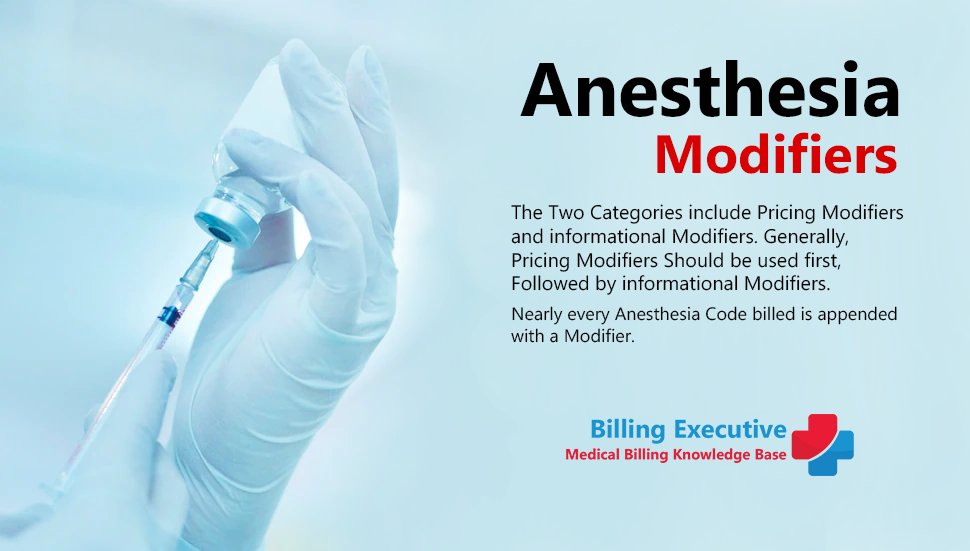Anesthesia coding and billing require great attention to detail. Not only is documentation, start and stop times, and code choice critical, but so are determining the correct modifiers, correctly implying the patient’s physical condition, and recording any other qualifying situations that may affect how claims are compensated.
This article provides a refresher on anesthesia modifiers, physical status, and qualifying situations, whether you are new to anesthesia coding and billing or an experienced professional.

Anesthesia Modifiers
Modifiers are two-digit codes added to CPT and HCPCS codes to provide further data. They are divided into two categories and two levels. The American Medical Association maintains and updates Level I modifiers with two numeric digits (AMA). The Centers for Medicare and Medicaid Services maintains and updates Level II Modifiers with two alpha digits (AA through VP). Pricing and informational modifiers are the two types of modifiers. Pricing modifier keys should always be used first, accompanied by informational modifiers.
A modifier is attached to nearly every anesthesia code that is billed. According to Medicare Administrative Contractor WPS GHA, the inaccurate use of modifiers is regularly among the top billing issues for federal, government, and private payers.
The anesthesia pricing modifiers listed below indicate who provided the anesthesia service and who should be invoiced in the first modifier profession.
AA – Personal anesthesia services provided by an anesthesiologist.
AD – A physician medically monitors more than four simultaneous anesthesia procedures.
QK – Medical supervision of two, three, or four concurrent anesthesia processes by a health care professional.
QY – An anesthesiologist oversees one CRNA/AA (Anesthesiologist’s Assistant).
QX – CRNA/AA service under the supervision of a doctor.
QZ – CRNA service provided without the supervision of a physician.
Anesthesia Informational modifiers
Anesthesia-based modifiers are only for data and should come after the reimbursement modifiers. Although there is no extra payment for information-based modifiers, they are essential for billing.
QS – stands for monitored anesthesia care service.
G8 – Monitored Anesthesia Care (MAC) is used for sophisticated, complicated, or significantly invasive surgical procedures. This modifier may be billed by either a CRNA or a physician. Only anesthesia procedure codes should be reported, and the actual anesthesia time should be specified on the claim.
G9 – Monitored Anesthesia Care (MAC) for patients with a history of severe cardiopulmonary disease.
P1–P6 Anesthesia Physical Status Modifiers
The informational modifiers mentioned below indicate physical status during the anesthesia procedure. They must come after reimbursement modifiers.
Physical Status codes
The modifiers listed below are used to indicate physical status during anesthesia.
P1 – An average healthy patient
P2 – A patient suffering from mild systemic disease.
P3 – A patient suffering from severe systemic disease.
P4 – A patient suffering from a severe systemic disease constantly threatens life.
P5 – An unconscious patient who is unlikely to survive without the procedure.
P6 – A neurologically patient whose organs are being harvested for donation.
Qualifying circumstances
Qualifying circumstances are billed using add-on codes instead of modifiers, listed separately alongside the anesthesia code. Among them are the following codes:
99100 – Anesthesia for patients between the ages of one and seventy (1 unit).
99116 – Anesthesia made more difficult by using total body hypothermia (5 units).
99135 – Anesthesia made more difficult by using controlled hypotension (5 units).
99140 – Anesthesia made more difficult by emergency conditions (2 pieces).
According to the ASA, it is not suitable to code 99100 for anesthesia codes written for pediatric patients. Furthermore, codes 99116 and 99135, when conducted with cardiopulmonary bypass, should not be revealed when hypothermia or hypotension may arise due to the procedure. Review our billing regulations for more information on using modifiers when billing anesthesia services to Medicare.
About us
Billing Executive – a Medical Billing and Coding Knowledge Base for Physicians, Office staff, Medical Billers and Coders, including resources pertaining to HCPCS Codes, CPT Codes, ICD-10 billing codes, Modifiers, POS Codes, Revenue Codes, Billing Errors, Denials and Rejections.
We have more than 10 years experience in US Medical Billing and hand-on experience in Web Management, SEO, Content Marketing & Business Development with Research as a special forte.
Learn More
Medical Billing Tips and Tricks – Correct Use of Modifier 22
CPT Category Codes by Specialty 2022
How to Use Modifier 54 : Split Surgical Care
Updated List of CPT and HCPCS Modifiers 2021 & 2022
